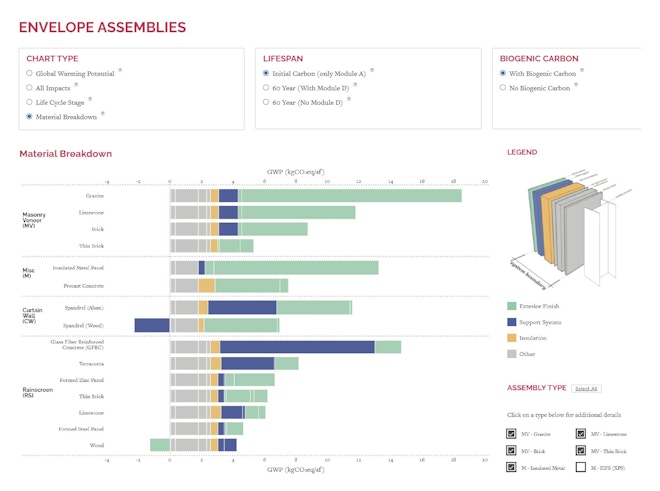Kaleidoscope: Bringing the Lens of Embodied Carbon to the Early Design Process - Becca McGee Sturgeon
... we know that a building causes environmental impacts far beyond the building site – and we know that there is a time value to carbon, and if we are going to meet emission reduction targets embodied carbon must have a seat at the table in design discussions.
What environmental impact does one object have on the world? This is the question at the core of life cycle assessments (LCA); the embodied carbon lens. As designers, we control and influence all kinds of things in the process of developing an architectural project – but time is not one of them. So, who has the time to ask a question like this? For better or for worse [read: for worse], outside of the educational realm, the current architectural practice rarely provides enough time to explore this type of examination. But we know that a building causes environmental impacts far beyond the building site – and we know that there is a time value to carbon, and if we are going to meet emission reduction targets embodied carbon must have a seat at the table in design discussions. However, more than just a call of crisis for architects to add to the ever-growing list of important lenses through which we weigh our decisions, with this lens comes the opportunity for elevated design – with the knowledge of what it means to extract, form, and ultimately assemble materials into the spaces we inhabit comes a deeper understanding and connection to the materials and their potential.
Typically, LCAs are done late in the process because they require a detailed 3D BIM model that does not generally exist early in design. Because they are often done later in design, they typically document rather than inform the design decisions. However, we have a much greater ability to impact change early in design development and it becomes increasingly difficult, and more costly, as a project progresses. There are many tools that currently run LCA studies, but based on our firm’s typical design process, we’ve found that they’re more suitable for when greater detail is known about a design. Following an internal research initiative spurred on by the question of how to get LCA-thinking into early design decisions, in October of 2020 Payette launched the open-source web-based Kaleidoscope: Embodied Carbon Design Tool, with the goal of integrating embodied carbon earlier into our design process.

Kaleidoscope web-based embodied carbon design tool
The concept of Kaleidoscope is to help designers easily explore apples-to-apples building assemblies to make more informed early decisions. Our tool is meant to bring embodied carbon to the table when the first conversations about materiality are happening, in a quick and accessible way. We chose to focus on envelopes for the first phase of the tool for a number of reasons; first, that the envelope is often one of the first parts of the design to be aesthetically considered with materials visualized, and second that in a typical building, envelopes can account for approximately 20% of the buildings embodied carbon[1]
– the largest slice of the pie that an architect has direct influence on. When we use Kaleidoscope to compare façade systems, it becomes much easier to understand the vast difference in embodied carbon between different assemblies and how simple changes can make a huge impact. To form an apples-to-apples comparison we eliminated the variable of operational energy by performing THERM heat flow models to ensure each wall system had the same R-Value, as well as system boundary.

Envelope assemblies viewed through global warming potential lens
Kaleidoscope allows you to compare the embodied carbon of façade assembly types through multiple lenses; options to evaluate selections include different environmental impact categories, lifespan, and biogenic carbon.

Envelope assemblies viewed through material breakdown lens
The assemblies are organized by their general construction type (masonry veneer, curtain wall, rainscreen, and miscellaneous) and can be added to or removed from the chart by check boxes in the legend for focused comparisons. The data is presented in a per-square-foot basis, and a built-in calculator allows designers a simple metric to multiply by their own façade areas to compare options and combinations.

Design comparison of façade options using envelope calculator

Detailed view of assembly type
Kaleidoscope is created to supplement, not replace, whole-building LCA in early design phases. It is meant to be a reference for order of magnitude of early LCA decisions allowing designers to quickly compare the embodied carbon impacts of various standard façade systems, and in the most recent update, flooring assemblies which also integrates information on material health impacts of assemblies layering in the lens of material health (with more building assemblies to come).

Envelope assemblies viewed through all impacts lens
Ultimately, as designers our ideas manifest themselves in material. The life of a material beyond its building site is inextricable from the life of a material as it forms the buildings we inhabit. Kaleidoscope was born out of a desire to not only make sustainable practices accessible to architects – but specifically to bring a holistic mindfulness to material decisions. As designers shaping the built environment, we care about the materials we select, we care about the role these materials will play in the spaces we create; bringing the lens of embodied carbon asks that we truly evaluate the repercussions and opportunities these material decisions have on the world around us, and our future.
[1] K. Simonen, Testing Whole Building LCA: Research and Practice, 2015

Becca McGee Sturgeon
Payette
Becca is an Architect at Payette, where she primarily works within the firm’s science practice, focusing on renovation and adaptive reuse. In addition to her project work Becca is a co-creator of Kaleidoscope: Embodied Carbon Design Tool and co-leader of the firm’s Material Research Team whose initiatives are implementing a new healthy material policy, and LCA research. Prior to joining Payette, she worked as an Architectural R&D Designer in building materials and systems assembly design at Saint-Gobain Northboro Research and Development Center, and before that as a Senior Designer and Art Director for Qorvis MSLGroup, a mid-sized integrated communications agency located in Washington D.C.. Becca received her Masters of Architecture from the Rhode Island School of Design, and Bachelors of Art in Graphic Design with a minor in History from Western Connecticut State University.
Looking for something specific?
Search our extensive library.
FTI’s SKINS email is the central source for the latest in building skin trends and research.
All emails include an unsubscribe link. You may opt out at any time. See our privacy policy.









